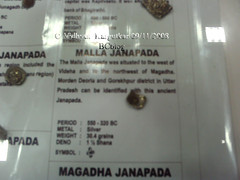Malla Janapada
The Malla Janapada was situated to the west of Videha and to the northwest of Magadha. Modern Deoria and Gorakhpur district in Uttar Pradesh can be identified with this ancient Janpada.
period: 550 - 320 B.C.
metal: silver
weight: 30.4 grains
deno: 1 1/2 Shana
Legend:
From the Mahabharata:
The epic Mahabharata speaks about a Northern Mallas and a Southern Mallas conquered by the Pandava Bhima during his military campaign through the eastern kingdoms to collect tribute for King Yudhisthira's Rajasuya sacrifice.
Mahabharata mention Mallas along with the Angas, Vangas, and Kalingas as eastern tribes. The Mallas were republican people with their dominion consisting of nine territories (Kalpa Sutra; Nirayavali Sutra), one of each of the nine confederated clans. Two of these confederations...one with Kuśināra (modern Kasia near Gorakhpur) as its capital, second with Pava (modern Padrauna, 12 miles from Kasia) as the capital, had become very important at the time of Buddha.
Kuśināra and Pava are very important in the history of Buddhism since Buddha took his last meal and was taken ill at Pava and breathed his last at Kusinara.
The Mallas, like the Lichchhavis, are mentioned by Manusmriti as Vratya Kshatriyas. They are called Vasishthas (Vasetthas) in the Mahapparnibbana Suttanta.
The Mallas originally had a monarchical form of government but later they switched to Samgha (republic) of which the members called themselves rajas. The Mallas were a brave and warlike people.
Jainism and Buddhism found many followers among the Mallas. The Mallas appeared to have formed alliance with Lichchhavis for self defense. They however, lost their independence not long after Buddha's death and their dominions were annexed to the Magadhan empire.
Monday, December 1, 2008
Subscribe to:
Post Comments (Atom)











No comments:
Post a Comment